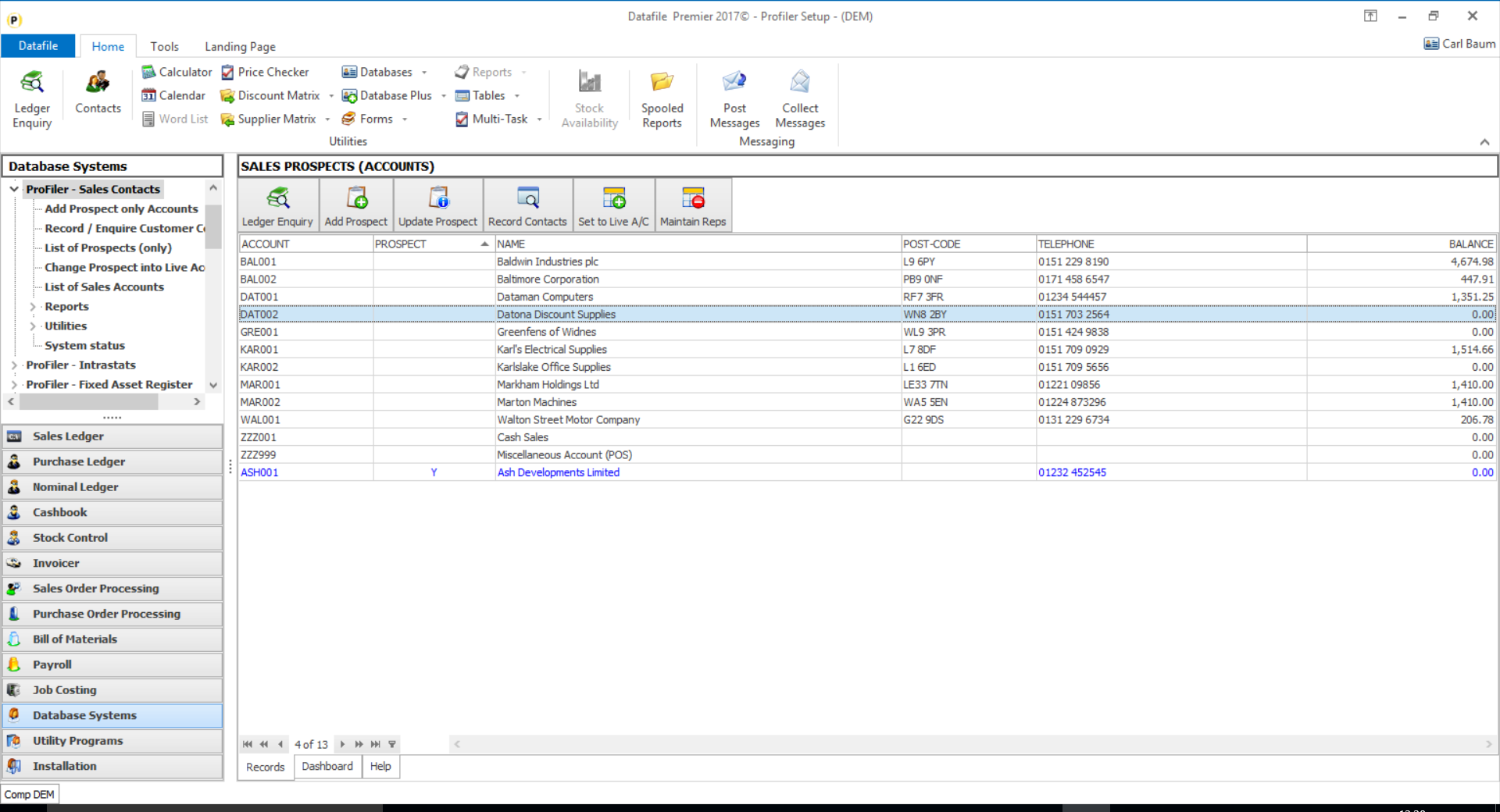
Datafile 2018 and above
This new feature extends the option for Landing Pages to ProFiler applications.

You have all the options as per the standard applications – record filters and conditional highlights, definable quick action links, dashboard display. In addition, if the Data Visualisations application is available you also get all the added features of this application.
Installation
Menu Design
To configure the Landing Page a new option ‘Landing Page Setup’ is available for the ProFiler Application Profiler menu. To add this option, sign on as the CONFIG user and select Application Menu Design and amend the PXAPP.D03
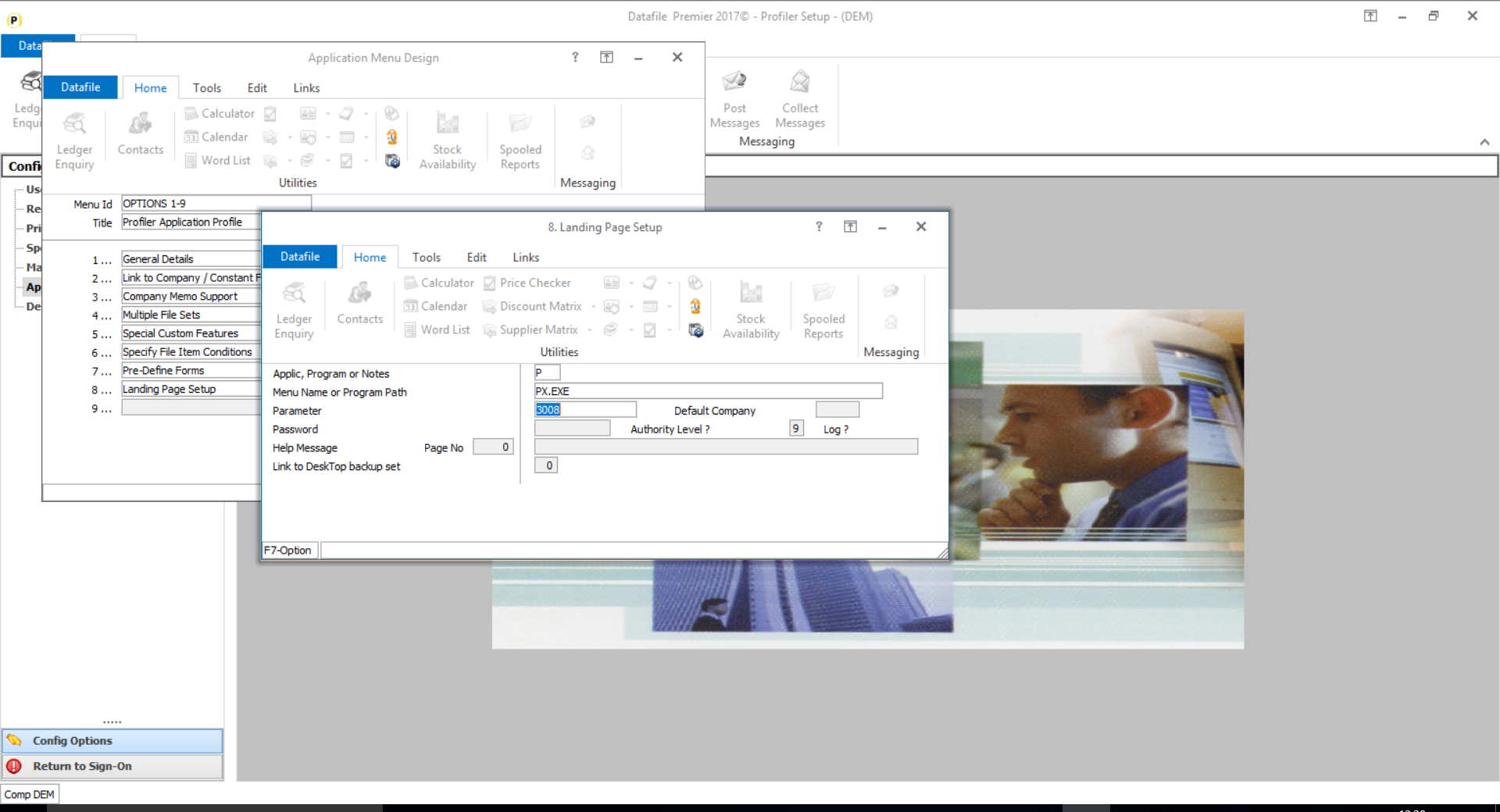
App, Program or Notes – P-Program
Menu Name or Program Path – PF.EXE
Parameter – 3008
Other options can be set as required.
Configuring the Landing Page
To configure the Landing Page for a ProFiler application, select Database Systems from the main menu followed by ProFiler Application Definition and then Application Profile and Landing Page Setup. The system will automatically select the most recently used application this session, if no application has yet been selected the list of applications will be offered for you.
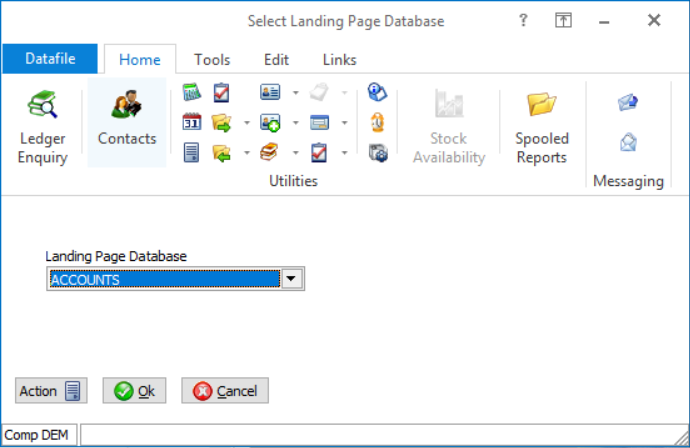
The first prompt asks you to Select Landing Page Database.
Any of the (maximum of) eight databases in use within the ProFiler application can be chosen as the basis of the landing page.
Select as required.
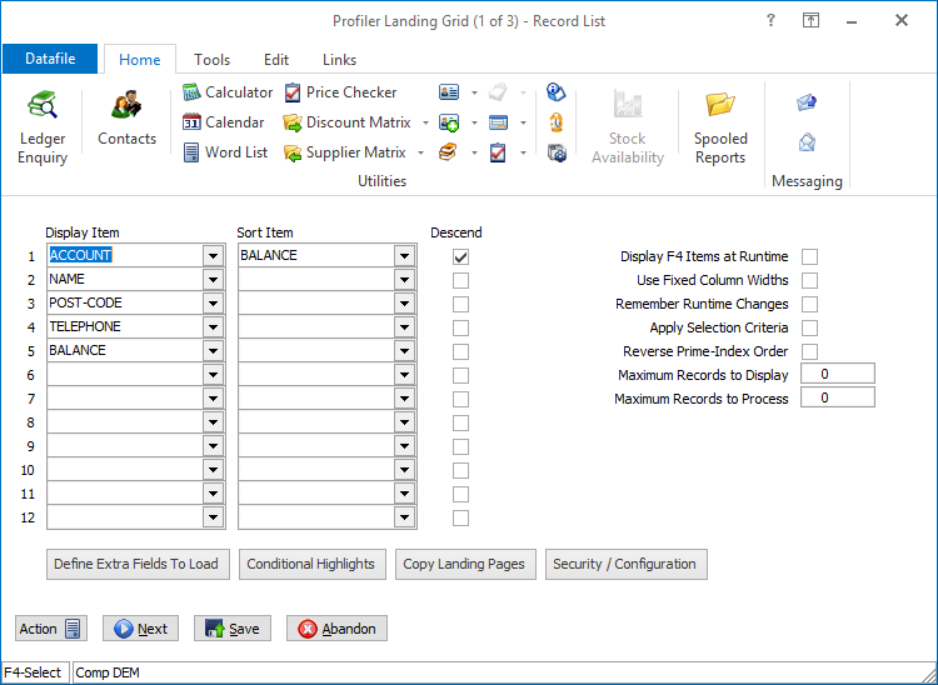
The initial page is like that of the main application landing pages.
Display Item – select up to twelve items from the main application database to be shown by default on the landing grid.
Sort Item (Descending) – select the data items to sort the initial landing page records on. Up to twelve items can be selected, by default these are sorted in ascending order but you can sort in descending order by setting the corresponding flag item.
Display F4 Items at Runtime – If no items are set then the system automatically uses the F4 pick items as the data items list. Setting this option overrides any set items with the F4 pick items also.
Use Fixed Column Widths – set to prevent the user changing the default display widths of the data items listed.
Remember Run Time Changes – set to remember, per user, any changes to display widths made.
Apply Selection Criteria – set to apply any criteria to restrict the records displayed to only those records that match the criteria.
Reverse Prime-Index Order – on smaller databases you may want to set this option to show the latest entry at the top. Generally though where this item likely to be required (Sales Order Processing, Purchase Order Processing or Bill of Materials) you would usually set to sort the list on the Order Reference in descending order.
Maximum Records to Display – set to restrict the number of records displayed on the panel.
Maximum Records to Process – set to limit the number of records to process – this applies to the panel and dashboard and is useful to restrict entries where a large volume of historical data is held.
Define Extra Fields to Load
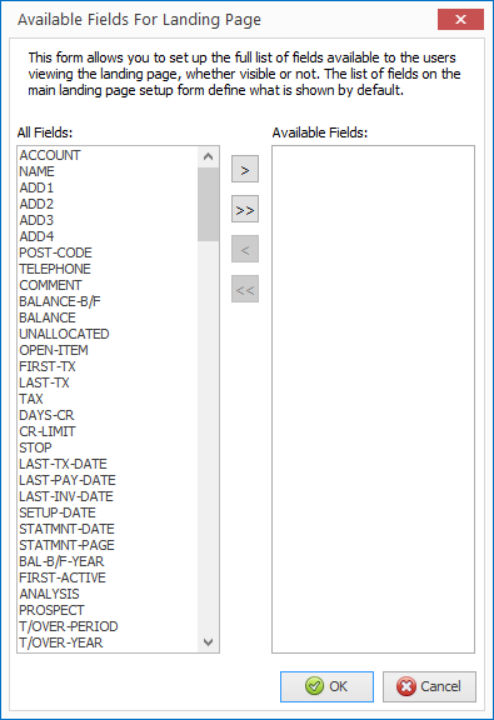 Selecting this
option allows you to define which data items are available to be added by the
operator to the landing grid at run-time and which items conditions, both
individual and shared can be defined against.
Selecting this
option allows you to define which data items are available to be added by the
operator to the landing grid at run-time and which items conditions, both
individual and shared can be defined against.
You can select individual items to be available as required – highlighting the item and selecting the ‘>’ icon.
You can set all items to be available by selecting the ‘>>’ icon. You can move items from the Availability list by selecting the ‘<’ and ‘<<’ icons.
Premier options to define authority levels for data items still apply – so you can, for example, allow the stock cost price to be available but if the user does not have authority to view that item they will not be able to view the content of the item.
Conditional Highlights

Selecting this option allows you to define the highlight rules to be applied.
There are two types of highlights – Filters or Formula Builders.
Selecting the option displays the existing highlight rules.
To add a new rule right click in blank space and choose to add a condition (you can also press the INS key)
To edit or remove a rule right click the entry and choose as required. If you highlight the rule you can use ENTER key to edit or DEL key to delete.
Rules are applied in the list order – you can move items up or down the list by right-clicking the item and choosing to Move Up/Down as required.
You can disable the highlight by selecting the tick box at the start of each rule. This leaves the rule available to be re-applied later if required.
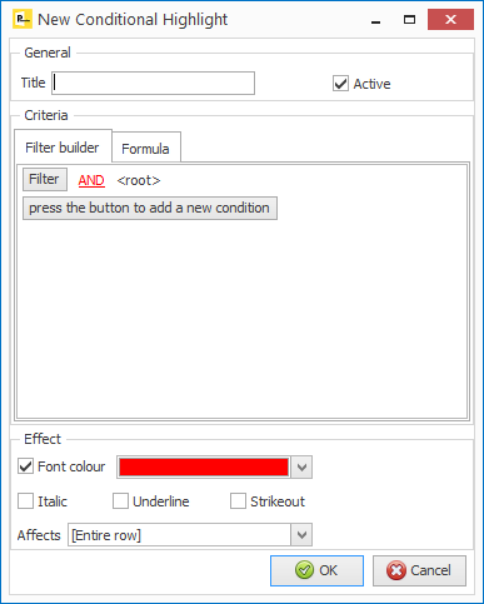
The top section of the display – General - gives the option to define a title for the highlight and to select whether the rule is active.
The bottom section of the display – Effect – allows you to define the visual aspect of the rule.
You can change the Font Colour to the colour specified and/or you can set whet the data is displayed in italics, underlined or in strikeout.
You can also control whether the display affects the entire row or an individual data item in the grid.
There are two types of criteria – Filters or Formula.
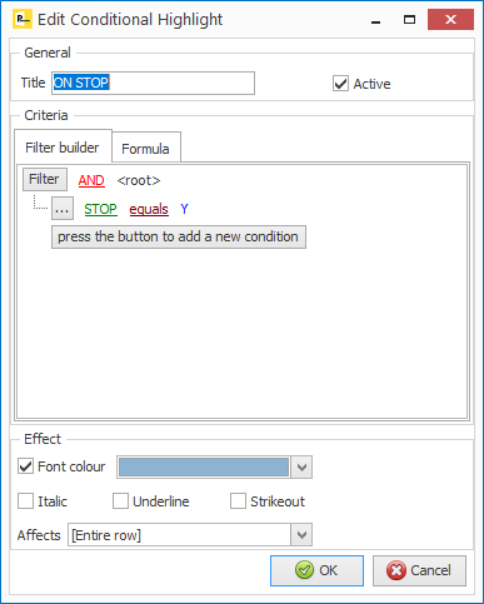 Filter Criteria – this option allows you to select a data item and
apply a condition against it. Check that
the STOP flag equals ‘Y’ on account for example.
Filter Criteria – this option allows you to select a data item and
apply a condition against it. Check that
the STOP flag equals ‘Y’ on account for example.
The standard options for equal / not equal / greater than / less than and so on are available and will be familiar to users who have used the standard selection criteria options. Other options will be more familiar for those who have defined SQL criteria.
Like / Not Like – this is matching patterns within data and is like the Equal/Not Equal value options in the usual Datafile criteria when using the # wild cards. Here you can enter a value such as %CARD% and will list any of the records where the key item includes CARD, but you can also use C%TEAK – so that key item starts with C but contains TEAK.
In / Not In – allows you to define multiple values so could define that, for example, that the ‘City’ line of an address is in ‘Liverpool’ or ‘Manchester’ and so on.
The values available on criteria change based on the data item type. With Dates for example you get a series of extra options so that can highlight that the date is in the past / future / today and so on.
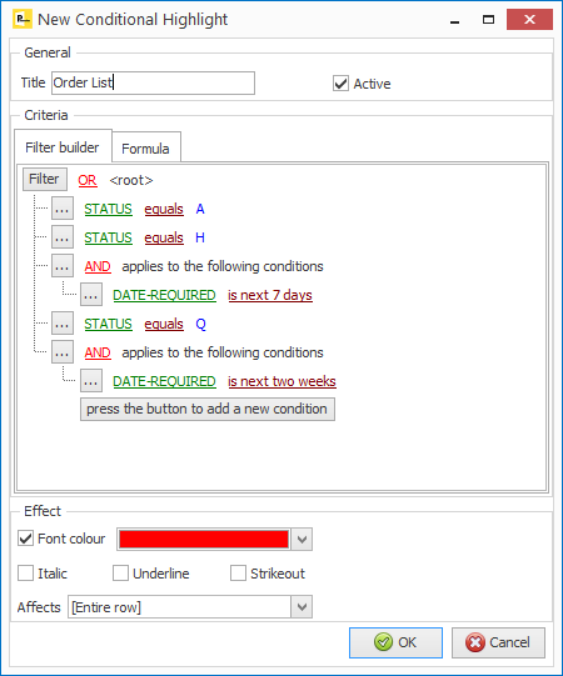 You can add multiple lines
of criteria = the criteria apply on a ‘AND’ (or Compulsory basis) by default
but you can select the AND option and change to OR as required.
You can add multiple lines
of criteria = the criteria apply on a ‘AND’ (or Compulsory basis) by default
but you can select the AND option and change to OR as required.
You can also ‘nest’ conditions – showing, for example, highlight orders where status is Active or Hold or Quote but only show Held Orders where the date required is in the next 7 days, and Quotes only if in the next 14 days, etc.
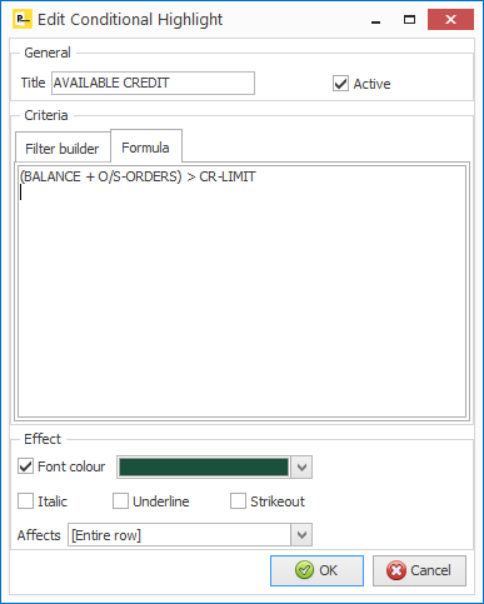 The Formula option allows you to compare
data items and highlight on a TRUE result – for example highlight sales
accounts where (BALANCE + O/S-ORDERS) > CR-LIMIT
The Formula option allows you to compare
data items and highlight on a TRUE result – for example highlight sales
accounts where (BALANCE + O/S-ORDERS) > CR-LIMIT
You use any of the data item names that are defined within the available selection items.
You can also combine criteria so, for example, you could modify the above along the lines of:
((BALANCE + O/S-ORDERS) > CR-LIMIT) AND (CR-LIMIT <> 0)
to show accounts where the balance plus outstanding orders is greater than the credit limit but only when the credit limit is not 0.
Copy Landing Pages
Each user gets the default landing page setup – display items / shared highlights – the first time they use the application. After these amendments, such as adding their own filters, data items, highlights, group items etc. are applied to their landing page alone. This option gives the facility to copy, either individual or all, landing pages from one user to another. For more detail on this option view the System Utilities section of this manual.
Security / Configuration
Only available if the Data Visualisations tool is configured this option allows individual applications to revert to the ‘standard’ landing page setup and to set authority levels for the creation / update of record sets. Again for more detail on this option view the relevant section of this manual.
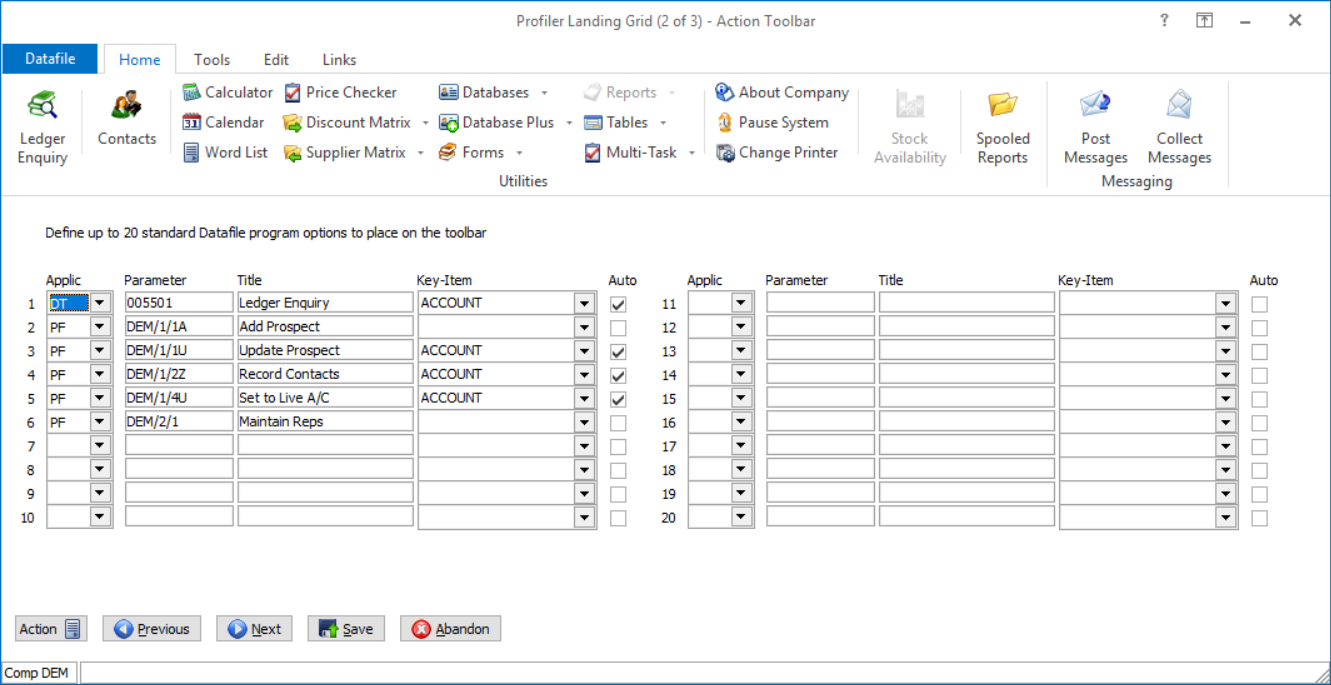
Define up to 20 actions that are to be displayed above the selected records. For each action you choose
![]() Applic – select the application to call. Usually this will be the code for the current
application (PF) but you may, for example, add to a list on the Sales Accounts the
ability to create a new sales order. Use
the drop-down list as required.
Applic – select the application to call. Usually this will be the code for the current
application (PF) but you may, for example, add to a list on the Sales Accounts the
ability to create a new sales order. Use
the drop-down list as required.
![]() Parameter – for standard application options this
refers to the menu parameter for the action, for ProFiler applications this
option asks you to select the action option in the format AAA/M/O – where AAA
is the three-digit application id, M is the Menu and O is the Option No. In the case of ProFiler actions and standard
actions the F7-Option key is available to assist in selecting the
parameter. In the case of ProFiler
screen actions you can also add a letter to the end of the parameter – A for
Add, U for Update, V for View etc.
Parameter – for standard application options this
refers to the menu parameter for the action, for ProFiler applications this
option asks you to select the action option in the format AAA/M/O – where AAA
is the three-digit application id, M is the Menu and O is the Option No. In the case of ProFiler actions and standard
actions the F7-Option key is available to assist in selecting the
parameter. In the case of ProFiler
screen actions you can also add a letter to the end of the parameter – A for
Add, U for Update, V for View etc.
![]() Title – enter the title to be displayed for this
option.
Title – enter the title to be displayed for this
option.
![]() Key Item – for use with Auto functions select the
data item from which the system is to take the ‘key value’ used when performing
the action (i.e. the sales account for account actions, stock record for stock
actions and so on). Where the main file
for the landing page is not a prime-index file you can also select $RECNO for
profiler screen actions.
Key Item – for use with Auto functions select the
data item from which the system is to take the ‘key value’ used when performing
the action (i.e. the sales account for account actions, stock record for stock
actions and so on). Where the main file
for the landing page is not a prime-index file you can also select $RECNO for
profiler screen actions.
![]() Auto – select whether the system is to auto-select
the current highlighted record when selecting the action. Note that generally you only set this option
where the action relates to an individual entry.
Auto – select whether the system is to auto-select
the current highlighted record when selecting the action. Note that generally you only set this option
where the action relates to an individual entry.
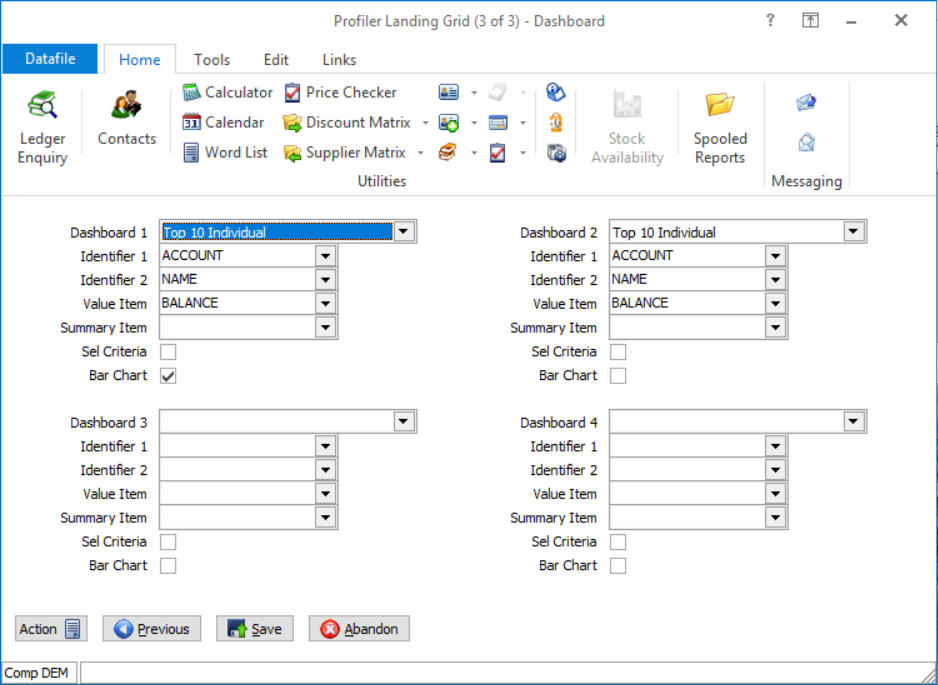
Only applicable where the Data Visualisations tool is not in use this option allows configuration of the Dashboard tab. The first prompt asks you to select the type of Dashboard to display. Options available include:
![]() Top 10 Individual – displays the top ten records
from the application database based on value item.
Top 10 Individual – displays the top ten records
from the application database based on value item.
![]() Bottom 10 Individual – displays the bottom ten
records from the application database based on value.
Bottom 10 Individual – displays the bottom ten
records from the application database based on value.
![]() Top 10 Summary – displays the top ten values for a
total item from the main application database. If using salespersons against the account you could display the top 10
salespersons for example.
Top 10 Summary – displays the top ten values for a
total item from the main application database. If using salespersons against the account you could display the top 10
salespersons for example.
![]() Bottom 10 Summary – displays the bottom ten values
for a total item from the application database.
Bottom 10 Summary – displays the bottom ten values
for a total item from the application database.
![]() Last 10 Records – displays the last 10 records
added to the main application database.
Last 10 Records – displays the last 10 records
added to the main application database.
Identifier 1/2 – only applicable for the Top/Bottom 10 Individual options select items to be displayed as required.
Value Item – applicable for the Individual / Summary option select the item to sort against.
Summary Item – only applicable for the Top/Bottom 10 Summary option select the grouping item to process for.
Sel Criteria – applicable for the Individual / Summary options select which of the main application records are to be included in the list / total. Leave blank for all.
Bar Chart – applicable for the Individual / Summary options select if the list is to be displayed as a bar chart instead.
Article ID: 2239
Created On: Thu, Jun 18, 2020 at 3:04 PM
Last Updated On: Mon, Jun 19, 2023 at 7:31 PM
Online URL: https://kb.datafile.co.uk/article/profiler-application-landing-pages-2239.html